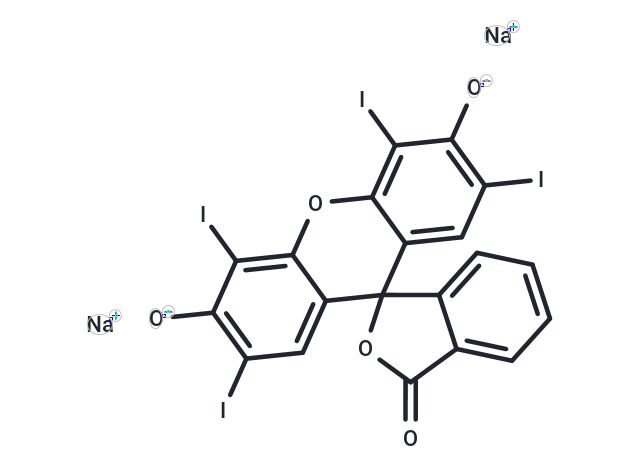Shopping Cart
Remove All Your shopping cart is currently empty
Your shopping cart is currently empty
Erythrosine B (Erythrosine I) , a tetraiodofluorescein, is served as a red coloring in some foods (cherries, fish), as a disclosure of dental plaque, and as a stain of some cell types. Its structural was similar to thyroxine.

| Pack Size | Price | USA Warehouse | Global Warehouse | Quantity |
|---|---|---|---|---|
| 50 mg | $33 | In Stock | In Stock | |
| 100 mg | $47 | In Stock | In Stock | |
| 200 mg | $68 | In Stock | In Stock | |
| 500 mg | $112 | In Stock | In Stock | |
| 1 mL x 10 mM (in DMSO) | $50 | In Stock | In Stock |
| Description | Erythrosine B (Erythrosine I) , a tetraiodofluorescein, is served as a red coloring in some foods (cherries, fish), as a disclosure of dental plaque, and as a stain of some cell types. Its structural was similar to thyroxine. |
| Cell Research | Instructions I. Solution preparation 1. Mother solution preparation: Dissolve Erythrosine B in an appropriate solvent, such as anhydrous DMSO, ethanol or water, to prepare a stock solution of the required concentration. The recommended concentration of the stock solution is 10-100 mM for subsequent dilution. 2. Working solution preparation: Dilute the mother solution into the working solution to be used according to the experimental purpose. II. Operation steps Cell staining 1. Culture the cells to an appropriate density. 2. Wash the cells with PBS and remove the culture medium. 3. Add the diluted Erythrosine B solution to the cells and incubate at 37°C in the dark for 15-30 minutes. 4. After incubation, wash the cells 3 times with PBS to remove unbound dye. 5. Fluorescence detection: Use a fluorescence microscope or flow cytometer for detection. The excitation wavelength of Erythrosine B is about 530 nm and the emission wavelength is about 550 nm. Precautions: 1) Wear gloves during operation to avoid contact between skin or mucous membranes and reagents. 2) Avoid light exposure during incubation and storage to prevent fluorescence quenching. 3) After staining, fluorescence detection and analysis should be performed immediately. |
| Synonyms | Erythrosine I, Erythrosin extra bluish, Erythrosin B |
| Molecular Weight | 879.86 |
| Formula | C20H6I4Na2O5 |
| Cas No. | 16423-68-0 |
| Smiles | C1=CC=C2C(=C1)C(=O)OC23C4=CC(=C(C(=C4OC5=C(C(=C(C=C35)I)[O-])I)I)[O-])I.[Na+].[Na+] |
| Relative Density. | 0.98 g/cm3 |
| Color | Red |
| Appearance | solid |
| Storage | keep away from direct sunlight | Powder: -20°C for 3 years | In solvent: -80°C for 1 year | Shipping with blue ice/Shipping at ambient temperature. | ||||||||||||||||||||||||||||||
| Solubility Information | DMSO: 60 mg/mL (68.19 mM), Sonication is recommended. | ||||||||||||||||||||||||||||||
| In Vivo Formulation | 10% DMSO+40% PEG300+5% Tween-80+45% Saline: 2.5 mg/mL (2.84 mM), Sonication is recommeded. Please add the solvents sequentially, clarifying the solution as much as possible before adding the next one. Dissolve by heating and/or sonication if necessary. Working solution is recommended to be prepared and used immediately. The formulation provided above is for reference purposes only. In vivo formulations may vary and should be modified based on specific experimental conditions. | ||||||||||||||||||||||||||||||
Solution Preparation Table | |||||||||||||||||||||||||||||||
DMSO
| |||||||||||||||||||||||||||||||
| Size | Quantity | Unit Price | Amount | Operation |
|---|

Copyright © 2015-2025 TargetMol Chemicals Inc. All Rights Reserved.